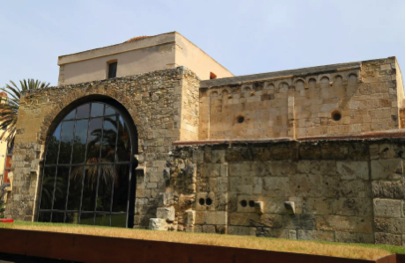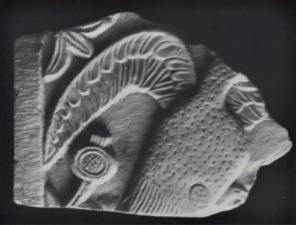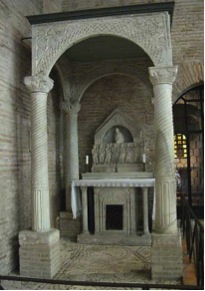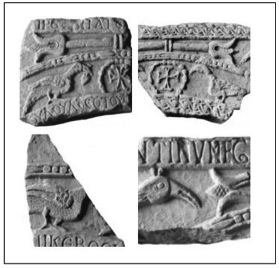Fragments of liturgical furnishings
Seven fragments of ciborium arches (fig. 2) were found in the basilica (fig. 1) in the 1950s. These were the architectural structure that stands over and covers the altar, similar to a canopy (figs. 3-4). They are made of white marble slabs decorated with slatted cornices, peacocks, crosses, leaves and other parts of plants. They have been compared with several sculpted elements from church architecture from all over southern Sardinia, and attributed to middle-Hellenistic production, also found in southern Italy, especially in Campania. They have been dated to the second half of the 10th century and are a sign of life and importance of the church furnishings, perhaps related to a recovered Christian use, if one believes the hypothesis of a Muslim presence on the site, as stated in some documents, such as a kufic graffiti and an inscription (see finding no. 6). Following the discovery and restoration of the church, they were inserted in the buffer wall of the northern arch of the domed part of the building - which now no longer exists and has been replaced by windows - and can no longer be found.




Bibliografia
- P. CORRIAS, S. COSENTINO (eds.), Ai confini dell’Impero. Storia, arte e archeologia, Cagliari 2002.
- R. CORONEO, Marmi epigrafici mediobizantini e identità culturale greco-latina a Cagliari nel secolo X, in Archivio Storico Sardo, XXXVIII, 1995, pp. 103-121.
- R. CORONEO, Scultura mediobizantina in Sardegna, Nuoro, 2000.
- R. DELOGU, L’architettura del Medioevo in Sardegna, Roma 1953.
- R. DELOGU, Vicende e restauri della basilica di S. Saturno in Cagliari, in Studi sardi, 12-13, 5-32.
- R. MARTORELLI, Le aree funerarie della Sardegna paleocristiana, in P.G. SPANU ed., Insulae Christi: il Cristianesimo primitivo in Sardegna, Corsica, Baleari. Mediterraneo tardoantico e medievale: scavi e ricerche, 16, Cagliari-Oristano 2002, pp. 315-340.
- D. MUREDDU ET ALII, Sancti innumerabiles. Scavi nella Cagliari del Seicento: testimonianze e verifiche, Oristano 1988.
- D. SALVI, Cagliari: San Saturnino, le fasi altomedievali, in P. CORRIAS, S. COSENTINO eds., Ai confini dell’Impero. Storia, arte e archeologia della Sardegna bizantina, Cagliari 2002, pp. 225-229.
- D. SALVI, Cagliari: l’area cimiteriale di San Saturnino, in P.G. SPANU ed., Insulae Christi: il Cristianesimo primitivo in Sardegna, Corsica, Baleari. Mediterraneo tardoantico e medievale: scavi e ricerche, 16, Cagliari-Oristano 2002, pp. 215-223.

 VR
VR